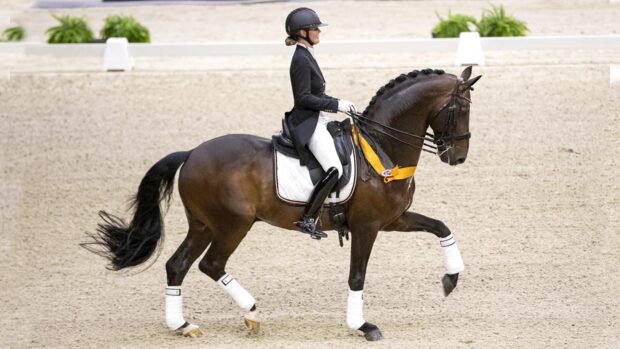What happens at the grading?
All stallions are shown on hard ground — in walk and trot — then presented in-hand on a triangle and let loose. They are later shown as a group in their age category. The final phase is loose jumping.
How are the marks distributed and what qualities are looked for?
Marks are given for type and conformation, correctness and quality of paces and jumping. There are two marks for jumping, four for gaits and six for conformation.
How many judges grade the stallions?
Two, at least one of whom is an established warmblood judge from Europe.
Which horses are eligible?
Stallions must be a minimum of 50% warmblood and with three generations of graded parentage. An exception is Thoroughbred stallions, and those with Thoroughbred damlines, where only the first dam must be graded.
A stallion for inclusion on the British Sports Horse Register (BSHR) must have a minimum of 25% graded warmblood in its pedigree or at least one graded BSHR parent.
All stallions must be registered with the BWBS or BSHR. No albinos or cremellos are eligible.
Colts should appear for grading at the age of two. Three-year-olds will be compared to mature stallions unless a veterinary certificate states they were unable to attend grading at the required age due to accident, sickness or injury. All stallions must be a minimum height of 153cm (15hh) at grading.
Do stallions need a prior veterinary examination?
An examination by a BWBS-approved vet is mandatory not more than two months before grading.
How many stallions come forward and what percentage is successful?
In recent years, around 20 stallions have come forward and approximately 40% have graded.
What are the different levels of grading?
Group III (basic level), Group II and Group I.
What is your assessment of the standard of presentation? How should people prepare?
In general, the fitness and condition of stallions is acceptable to good. People are increasingly aware of the need for professional help. The weakest area of preparation is free jumping — people don’t always grasp the amount of training needed to ensure the horse can give of his best. It’s a big problem with older stallions, who have been jumped under saddle and are then unprepared for loose jumping.
Do you have turn-out rules?
Stallions must be plaited with white tape and wear a single bridle without rollers or side-reins. It is recommended that horses are fit, not fat. All handlers should wear white or navy trousers and a shirt or jumper — running shoes are advisable. No breed society or stud logos except those of the BWBS are permitted.
What is the entry fee and is any documentation required on the day?
£250-£300.
After grading, does the stallion have to be reinspected?
Stallions usually attend a BWBS/BSHR grading only once. However, some horses may have restrictions placed on them by the judges. These could include reappearing at a grading again at a later date or having a progeny inspection.
Dates and venues of all 2007 gradings
Hartpury College in October/early November. Contact: (tel: 01497 822170) www.bwbs.co.uk



